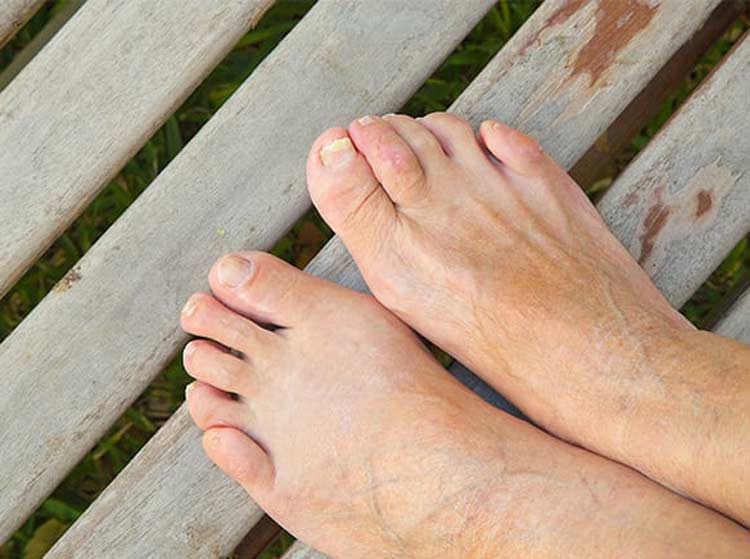

Discover how we can help you find relief from hammertoe.
When ligaments and muscles in the middle of a toe joint are imbalanced, a toe sometimes becomes misshapen or stuck in mid-flex position. It’s a condition commonly referred to as hammertoe. The deformity may become painful if the top of the bent toe rubs against shoes during normal movements. While hammertoe isn’t usually able to be completely reversed without surgery, issues related to it can often be successfully managed or improved with conservative treatments.
- Women often report discomfort from hammertoe more than men, primarily due to footwear choices.
- Diabetics and individuals with poor circulation in feet need to be especially cautious with foot defects like this.
What Are the Different Types of Hammertoe?
Typically affecting the second, third or fourth toes, hammertoe can be either flexible or rigid. With the flexible version of the condition, the affected joint of the toe can still be moved. It’s this type of hammertoe that often responds well to early treatment efforts. The rigid form of hammertoe is characterized by tendons in the toes that have become so inflexible that the affected joint cannot be moved. Surgery is usually recommended with this type of hammertoe.
What Causes It?
Under normal circumstances, the tissues in toes allow for smooth movement. With hammertoe, there’s an imbalance with the tissues around the toe’s joint. This imbalance causes the toe to become deformed because of the added pressure on tissues. It can occur due to changes within the foot due to aging, because of an injury, or as a reaction to arthritis and other conditions that affect tissues. Ill-fitting shoes may also contribute to hammertoe. Risk factors also include genetics, other conditions affecting toes such as bunions, and previous injuries to toes.


What Symptoms May Be Experienced?
Other than a visibly bent toe, signs of hammertoe may include pain in the toe that’s affected and difficulty walking. There may also be noticeable difficulty moving or flexing it. Discomfort is sometimes experienced while wearing shoes. Some individuals will develop corns and calluses on top of the toe that’s deformed. Symptoms may also include:
- Redness and inflammation
- Burning sensations
- Open sores (in severe cases)
- Pain in the ball of the foot under the bent toe
How Is It Diagnosed?
A thorough examination that includes an X-ray is usually what’s done to diagnose hammertoe. Other image tests such as an MRI or CT scan may be performed if it’s suspected that other tissues in the affected part of the foot may also be damaged.
How Do You Manage Hammertoe Without Surgery?
Many of the treatment options available for hammertoe do not involve surgery. Gentle foot massages may help loosen tight ligaments and muscles. Changes to footwear often reduces the friction on the bent toe that contributes to discomfort. Placing ice packs on the affected toe may reduce swelling.
Anti-inflammatory medications and cortisone injections directly into to the tissues of the bent toe sometimes provide relief. Splinting and foot exercises in the early stages of the condition may restore balance to soft tissues in toes.
Should blisters develop on the toe that’s bent, it’s important not to pop them. Doing so may result in an infection. This can be especially serious for patients with other health issues that may make healing of open wounds on feet difficult.
Surgery Options
If conservative treatments aren’t working or if hammertoe is severe and tissues are rigid, surgery may be recommended. Some newer techniques involve the use of an implant device, otherwise more complex procedures are typically performed to correct severe cases of hammertoe. When the problem isn’t too severe, a small piece of bone around the toe joint may be removed to restore balance to ligaments and muscles.
Surgery might also involve repositioning the toe, completely removing the deformed or damaged bone, or correcting alignment issues with tendons, ligaments, muscles, and joints. Most surgical options for hammertoe are usually done as outpatient procedures. After surgical treatment, some degree of physical therapy may be recommended to recondition the toe that was previously bent.
Using non-medicated padding and wearing properly fitting shoes with a wider and deeper toe box may allow some patients with hammertoe to avoid surgery by preventing excessive irritation of the toe that’s affected. Custom orthotics can also be beneficial for some individuals with this deformity. Because hammertoe is a progressive condition that tends to get worse over time, it’s best to seek treatment from a foot specialist as soon as there is any noticeable discomfort from it while the joint is still moveable.